Before we begin, let me give out an honorary award I hope to make a regular tradition: The "It Wasn't THAT Bad" award. This is a special endowment I bestow upon a film that I feel was unfairly and unfortunately maligned by both critics and audiences. A special prize for one film that may not receive recognition in my top ten, but deserves more recognition than it got. The guilty pleasure, if you will. This year, that film is MacGruber.
Honorary Award: MacGruber
"If ripping throats gets that warhead back, I'll suck as many dicks as I've go— I'll rip as many throats as I have to!"
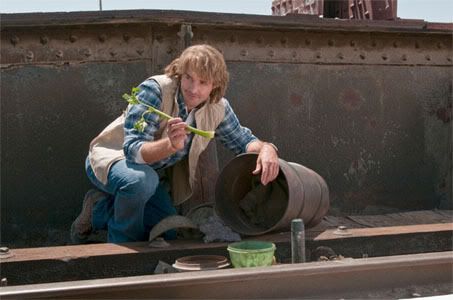
It Wasn't THAT Bad
MacGruber is a feature-length adaptation of the popular Saturday Night Live sketch, which explains a good portion of why people ignored it. MacGruber is a pastiche and parody of MacGyver and other action shows from the 80's. I laughed my ass off at this movie, honestly believing it to be the next big, raunchy comedy. The type unfunny people would quote out of context until I stab them in the throat with a Bic pen.
But no. No one saw MacGruber. Granted, it's not a masterpiece of filmmaking, but with certain comedies like this, you let storytelling fall by the wayside in exchange for laugh riots. A bad movie that's funny is not a bad movie.
I read several reviews for the movie, and they all seem to reach the same basic consensus: MacGruber was low-grade humor coupled with a nostalgia for a desirably forgotten era. Normally, I'd let that go. Who cares what critics say anymore? There was just one minor detail; Macgruber was not the only raunchy, lowest-common-denominator comedy brimming with 80's nostalgia. There was a second: Hot Tub Time Machine.
MacGruber barely made a blip on the radar. Hot Tub Time Machine opened to generally favorable reviews and a number-one weekend. I saw both films. MacGruber was funny. Hot Tub Time Machine was stupid and painful. There was a Michael Jackson joke. A joke they deemed so funny, they decided to use it in the trailer. Hackneyed comedy writers of America, hear me: Michael Jackson is dead. It's time to move on. Anybody who says MacGruber was bad and Hot Tub Time Machine was good has no business making assertions on any subject.
I guarantee Comedy Central will pick up the broadcast rights for MacGruber fairly soon, but a TV edit will not do the film justice. They went for a hard R, and it was well-earned. Like I said, MacGruber is not a great film. It's not in my top ten, and was never even the running, but the general wackiness is on par with Hot Shots and Austin Powers. And for a comedy, that's all you need.
Now on with the countdown:
"The rumors of my promiscuity have been greatly exaggerated. "
10) Easy A

When seeing movies outside of my demographic, I get paranoid. Walking into the theater, I always imagine one person is staring at me wondering if whether I'm in the wrong theater or if I'm some sort of pervert. Easy A was one of those experiences. I wasn't looking for a sleeper hit; I was completely bored and I needed a laugh. I probably would have skipped over it altogether since The Scarlet Letter was never a favorite book of mine, but I gave it the benefit of the doubt because I'm a sucker for postmodern interpretations.
The whole film examines the hypocrisy of sexuality in the modern world, especially at the teenage level. Supposedly, everything about sex is all right except for the actuality of women having sex. We've inadvertently created a society where a woman's ultimate goal is to be a sixteen year-old cocktease. Our hero, Olive doesn't ask to be thrust into the position of America's sexual liberator, but some people just have leadership thrust upon them. At times she treats it as a genuine crusade, other times a satirical expose, and sometimes, she just throws her hands up and declares, 'if you're going to villanize me, I'm going to be a fucking villain!'
My main grievance with the movie is the very puffy Amanda Bynes. Her appearance is an automatic point deduction. Also, there's a subplot involving Lisa Kudrow and Thomas Hayden Church that doesn't really percolate and just distracts from the story at hand. In the end though, I liked the movie. It was funny, it was genuine, and it was smart. Hell, it was even genius in some places. An overall enjoyable experience, even if it did mean attracting a roomful of gazes from wary teenagers.
"I saw the best minds of my generation destroyed by madness, starving, hysterical, naked, dragging themselves through the negro streets at dawn looking for an angry fix."
9) Howl
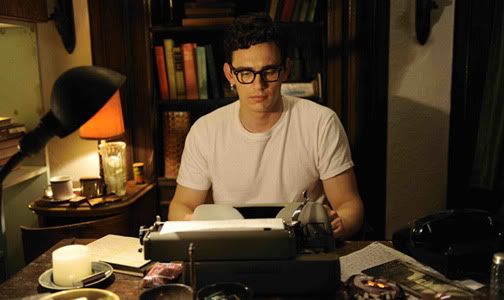
I'm no phony, so I will admit my intellectual shortcomings instead of masking them in a mound of BS. I've never read a word of Allen Ginsburg in my life. You see that quote up there? They Might Be Giants used the first half of that quote in their song "I Should Be Allowed to Think," and I thought they were geniuses for that. Even months after seeing Howl, I haven't read a word. I'm terrible like that, but at least I'm honest. Also, no one looks good wearing a Tyrolean, and Pabst Blue Ribbon is terrible.
Howl is the historical narrative of beatnik poet and 60's countercultural icon Allen Ginsburg. Specifically, the film details the impact the titular epic poem, both its intended audience and the easily offendable. The film jumps across time showing Allen Ginsburg (played expertly by James Franco) narrating his life to a biographer, living life as a beatnik, writing Howl, debuting his poem in San Francisco, and defending it in an obscenity hearing.
The crowning achievement, however, is the animation. Roughly 40% of Howl is an animated recitation of the poem, breathing life and vivid imagery into the work that normally only manifests in the subconscious mind of the literati. To see the twisted, vivacious images of a man's imagination manifested into visual form is nothing short of amazing. It does to poetry what Fantasia did to music.
James Franco has proved himself to be one of the finest actors of our generation. He feels no shame appearing in Apatow productions, and can bring it in prestige pictures. Wherever Franco is heading, keep an eye on him. He's huge now, and he's just going to keep getting bigger.
"Which would be worse, to live as a monster or to die as a good man?"
8) Shutter Island
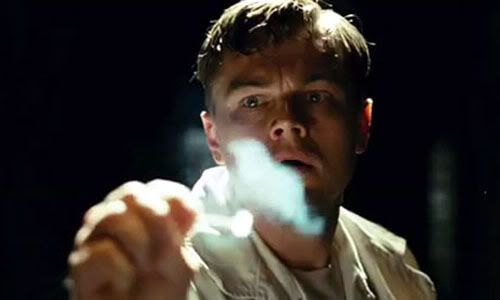
An equal mix of Alfred Hitchcock thriller and David Fincher mystery, Shutter Island was the first great film of 2010, and was the only great film for several months after.
Based on a book nobody's ever heard of, Shutter Island is the story of US Marshall Teddy Daniels investigating the disappearance of a patient at the Ashecliffe Hospital for the criminally insane. Which is on an island. With a shutter, apparently. The further Teddy investigates, the more he discovers about about the staff, the patients, and the nature of experiments performed. Soon, he fears for his own safety and sanity as the mystery begins to engulf him.
I can't do the story justice in written word, especially the climax. The revelation and withholding of information makes the film what it is. Many chide director Martin Scorsese for making a film so much in contrast with his previous works; to them, I say shut up. Martin Scorsese can make whatever film he Goddamn wants to make. This was an excellent film, and is right up there among his "more prestigious" works. Let the man have some fun once in a while. He'll get back to gritty crime dramas accenting the dual nature of New York City soon enough. The film also features memorable roles by Jackie Earle Haley and Max Von Sydow, two of my favorite actors. Shutter Island isn't a horror story in the traditional sense, but every time these two are onscreen, you get chills up your spine.
Shutter Island is one of those films that is better upon repeat viewings. Upon the first watch, you accept everything at face value, waiting for each turn. On each subsequent viewing, you acknowledge the turns, but try to interpret why they're happening, who is responsible for them, and what it all means on the grand scale. With every scene and every image, you have to decide whether this is part of the grand experiment, part of Teddy's distorted psyche, part of the day-to-day madness of the asylum, or just a freak coincidence. With these open interpretations, you could watch the film a hundred times, and never see the same film twice. Infinite re-playability is normally something I look for in a video game, but if a movie offers it as well, I'll accept it.
Also, this is a totally over-the-top, but "Who Is Sixty-Seven" is an anagram for "Its Noises Vex, Why?"
"You ever noticed how you let a Mexican into your house just because he's got gardening tools? No questions asked, you just let him right in. He could have a chainsaw."
7) Machete
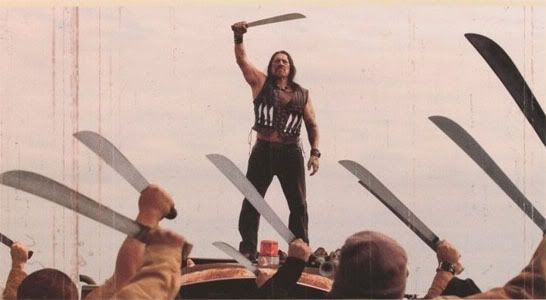
And now I talk about a big man with a big knife.
Machete, if you don't remember, was one of four faux-trailers which ran alongside 2007's Grindhouse double feature. It was a joke. Just like the rest of Grindhouse, it was completely over-the-top and ridiculous. But shortly sometime after its commencement, Robert Rodriguez looked at it and decided 'you know, I really want to make this movie.'
Danny Trejo is a badass motherfucker. That's all that needs to be said. There's no comparing him to other badass actors, no listing reasons he's awesome, no hyperbolic jokes about his feats of strength. You just take one look at the man, and you quake in fear. And he never sold Bowflex.
Let me ask one thing... Lindsay Lohan? I mean, really? What the hell? I don't like Jessica Alba either, but at least her character is essential to the story. Lindsay Lohan's entire role in the movie consists of sassing people who probably want to punch her in the face, getting hopped up on a load of drugs, making voyeuristic lesbian porn, waking up naked in the middle of nowhere, and putting on a silly costume. Come to think of it, did she even realize the cameras were rolling? That sounds like a normal day for Lohan. The icing on the cake, however, is her participating in the final showdown despite not being involved with any of the preceding events or characters leading up to this climax. She's firing an automatic weapon at a group of people she's never even seen before. How did she even choose sides? She doesn't ruin the film, but I'd love to see a special edition Lohanless version.
Machete is awesome in two regards: First, it's a continuation of Rodriguez's trademark no-holds-barred action style. Blood, violence, more blood, guns, knives, and lots more blood. In the first fifteen minutes, Machete rappels with some guy's intestines.
Second (and here's the political part), the film is a shot in the arm for the long forgotten exploitation genre. While normal films try to bank on celebrities, stories, or other normal subject matter, exploitation films try to entice audiences with the promise of seeing something taboo, lurid or controversial. Blaxploitation films were big in the 70's featuring urban African Americans overcoming Whitey with violence and cunning. Machete is in the same vein, but with Mexicans and Mexican Americans.
The sheer exaggeration of the anti-immigration themes is both hilarious and thought-provoking. Neither side is right in this scenario; we can't just allow everybody to cross our borders, but we can't turn the border into a demilitarized zone. But everyone has an opinion on why the other guy is wrong. By making the Mexicans a lethal, bloodthirsty alliance and the rich white Texans completely demonic, we get to step back from out prejudices and predilections. We are no longer parts of the immigration debate, but outside observers. We're no longer burdened by previous affiliations.
That's good satire.
"Fuck this shit, I'm getting the bazooka!"
6) Kick Ass
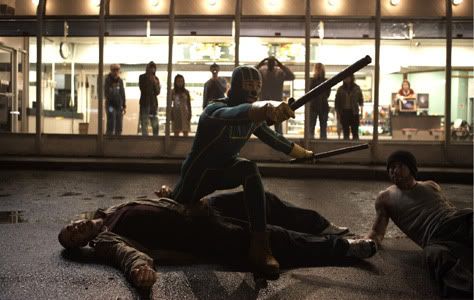
I loves me a good superhero movie. To my dismay, I didn't get it with Iron Man 2. And I sure as shit didn't get it with Jonah Hex. But luckily the good men and women of the indie circuit know how to get things done. I have no idea how they get it done, but I'm happy they get it done.
Kick Ass is the story of Dave Lizewski, typical geek, comic book aficionado and haircut procrastinator. Wondering why superheroes are delegated to the realm of fiction, Dave buys a neon green wetsuit, a pair of nightsticks, and introduces the world to "Kick Ass." Then Dave gets his ass kicked and immediately learns why superheroes are delegated to the realm of fiction.
Kick Ass masterfully balances comedy, black comedy, and action. There are pure wacky bits, bloody fights, scenes of torture, and people just plain having fun with weapons. Christopher Mintz-Plasse proved there is life after McLovin, Nicholas Cage is the good version of Nicholas Cage, and Chloe Moretz plays the best damn character of 2010. She will have a long and awesome career.
A lot of people dislike the abundant amount of brutal violence Kick Ass has to offer, completely missing the point. The point is: being a super hero is really stupid. You can do a million push ups every day of your life, but if two guys come at you with a knife, you're boned. Of course you're going to wind up tied to a chair with some guido bashing your kneecaps with a baseball bat. He's a professional muscleman. You're a kid who reads comic books.
No matter how much Christopher Nolan made Batman seem realistic, Kick Ass is as realistic as a superhero movie gets (minus the whole jet pack/minigun thing). Until scientists invent magic, you cannot be a superhero. It's impractical, infeasible, and traditional criminals will end you with conventional means. Your only hopes will be the element of surprise, and pure, unadulterated luck. But hey, it's just a movie. Nobody's dumb enough to try something in real life they've seen in a movie or on TV, right?
" You just headbutted my boyfriend so hard he burst!"
5) Scott Pilgrim Vs The World

This year, I received a lot of great gifts for Christmas, but Santa was outdone by my sister. She gifted me the entire Scott Pilgrim collection. In a fury of literacy not demonstrated since I discovered the library's Mad Magazine back catalog, I powered through all six volumes. I'll release a side-by-side comparison some day, but for now, let's stick solely to why the movie is awesome.
There are movies made for the digital generation, and there are movies for the digital generation. The difference being the former is an actual representation of the target audience, and the latter is some guy in a suit saying, "look, there are sexy teens doing what regular teens do. Buy a ticket dammit." Scott pilgrim is the former.
Right when the film began and Scott announced the name of one of his songs was 'Launchpad McQuack,' I knew this was as authentic as movies would get. We are a generation reared on computers, video games, MTV and caffeine, and we won't sit still for fluff and pandering. Anime has always been a thing, and homosexuality has always been an accepted lifestyle, and the movie behaves as such.
This movie is just over-the-top in mis-en-scene and ridiculous verisimilitude (I have a BA in film, remember?) This movie is so far gone from reality, it circles back around and passes it up again. It moves like a cartoon, looks like a video game, feels like an anime, and ultimately creates a unique environment never before experienced by anyone. I loved every moment of it. It was polished to a gleam, and really showed the tenacity and dedication of the filmmakers. It's appearing on a lot of top ten lists, and while it's not a top contender for the Oscars, I would thoroughly enjoy a dark horse nomination for art direction. No other film will ever look or feel like this one, and we should appreciate that.
There are a few problems I have with it. Mostly Ramona-related. I never really believed her infatuation with Scott. She always seemed wooden, distant and cold. As if she never really loved Scott, but just dated him out of frustration/pity because she was tired of his relentless fawning. I've heard it described as Twilight for boys, and in this sense, that's accurate.
Every other cast member brings their A-game. I'd never associate Micahel Cera with a story like this, but lo and behold, the miracle of acting! Kieran Culkin steals every scene he's in. Mark Webber and Allison Pill nail their characters. Every one of the evil exes is different and memorable. Even Johnny Simmons stands out despite playing a character specifically designed to blend into the background.
It's a six-volume story crammed into two hours. Everything compliments either the preceding or succeeding scenes, the callbacks are well-timed, and while a lot was cut from the books, everything that stays is stronger. The ending is also much more satisfying. That being said, maybe it's for the better this film bombed. I'd much rather have it as a cult favorite rather than an international hit. Yeah. That's how I'm rationalizing it.
"And now the spinning. Thank you for nothing, you useless reptile."
4) How to Train Your Dragon
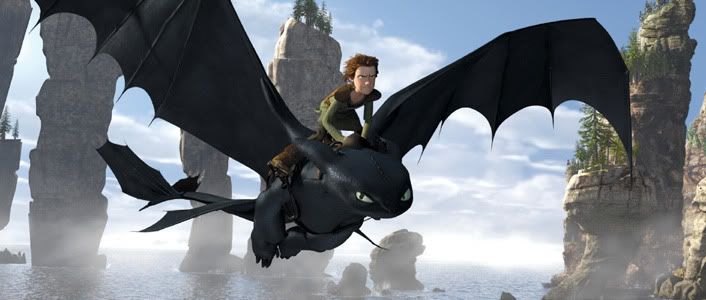
Dreamworks. The whipping boy of all internet movie commentators. Let me guess, another film about animals voiced by celebrities going on decidedly non-animal adventures while making puns? It was a big year for Dreamworks. A fourth Shrek movie, a totally-not-at-all-Incredibles-ripoff-just-another-movie-about-superheroes-with-e
I was quick to give HTTYD the brush-off. I mean, come on, it's Dreamworks. I ignored the trailers. I ignored the hype. I even ignored the glowing critical reviews. But then a weird thing started happening: I didn't hear anybody say a bad thing about it. Everybody loved it. Still, I was apprehensive. I waited for the film to migrate from the multiplex to the dollar show, and I saw it there. It was a crowded half-theater that smelled like stale nacho cheese (just as I remembered it), but holy hell. How to Train Your Dragon is the finest thing Dreamworks Animation has ever done.
Even without 3D, the film was a visual spectacle. It was the type of immersive environment filmmakers have forgotten how to create. It's not enough to show us things in 3D, you have to make us feel as if we're part of that world. 3D is just a gimmick; it's the effect you're after. To achieve that without the big plastic glasses is a true signal of animation excellence.
Plus, you know, vikings. That's always an extra point from me.
You know, I just realized how many similarities HTTYD has to Kick Ass. Both films star a young, nebbish hero trying to prove his might. Both films feature a young blonde girl who kicks everyone's ass. Both feature a large, mustached, muscular father-figure who indoctrinates their child with the importance of fighting, and both films star Christopher Mintz-Plasse.
Maybe Dreamworks has turned a corner. Maybe after making lowest-common-denominator films for a decade, they've proven heir stability. They're no longer standing in Pixar's shadow, but their worthy competitor. Maybe the days of epic animation are among us, retiring the cocked-eyebrow, half-smile plague that has... Ah, who am I kidding. Dreamworks got lucky. Cocked-eyebrow, half-smiling animals making puns is all they got.
++++++++++++++++++++++
Before I get to my top three, I have another honorary award to give: The "I'm an Idiot" award. This award goes to the film I most wanted to see this year, but due to limited releases, missed opportunities, and (mostly) my own sheer incompetence, I never managed to see. This year, I award the honor to Buried.
Honorary Award: Buried
"Oh no, I've been Buuuuuuuuuuuuuuuried!" (this quote may not actually appear in the film)
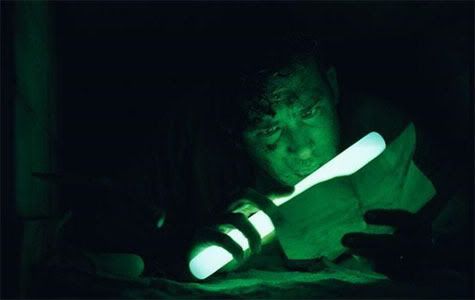
I'm An Idiot
Buried is (apparently) the story of Paul Conroy, an American contractor working in Iraq, who is ambushed, kidnapped, and wakes up in a coffin, buried alive. At his disposal is a cell phone with abnormally grand reception, a lighter, and his own wits.
I really wanted to see this. Ryan Reynolds is awesome when he's not in some formulaic romcom, and his ability to carry a scene coupled with the intense plot made for an interesting premise. I saw the poster at my local megaplex, and I checked the theater listings weekly to see if it was playing. A few weeks passed, then a few more weeks passed, then months passed, and I learned something: My local megeplex fucking lies about what movies they're getting.
Whether or not Buried was ever released in St. Louis, I may never know. Despite it's American cast and English dialogue, it was a Spanish film released on the indie circuit. And out in the midwest, getting anything from the indie circuit is a craps shoot. Still, it wouldn't have hurt me to check one other theater.
Congratulations, Buried. I am an idiot.
"...Oops"
3) 127 Hours

Aron Ralston is a badass. I mean this to the fullest extent. He's the stuff of legend. In my eyes, he's right up there with Pecos Bill and John Henry. As such, his biopic would also have to be the stuff of legends.
Unfortunately, his story consists of a man being trapped under a rock for five days. Which normally does not make for good cinema.
But just as Danny Boyle made "Who Wants to be a Millionaire" into a Bollywood picture, he does the impossible again. He made a film from the unfilmable. James Franco again proves his awesomeness with an A-Plus portrayal. I not only expect Franco to be nominated at the Oscars for this role, I expect him to win. His portrayal hits all the great acting apexes. Doubt, paranoia, fear, psychosis, insecurity, emotional pain, physical pain, longing, and lust. It redeems whatever the hell he was doing in the Spider-Man movies.
I was nervous going in that the climax was going to be a high-class version of Hostel. And, in a way, it was. The scene in question is very graphic and very disturbing. However, the masterful filmmaking by everyone involved makes it absolutely worthwhile. Throughout the movie, it's hinted that Aron's arm is going to have to come off. It's inevitable. By the time the scene in question rolls around, you NEED to that arm come off. If not, you will be grossly dissatisfied. Or dissatisfied by the grossness. One of the two.
The film is a masterpiece of 21st century editing. It knows when to go fast, and it knows when to linger. Parts seem like a music video, parts seem like a Vlog, and parts seem like the nightmare of a man who fell asleep watching TV commercials. Despite 85% of the film taking place in a narrow crevice, it never gets old, never gets boring, never gets dull. One word of warning: before watching, get yourself a very large beverage. Dehydration is a major theme, and they milk it for all its worth.
"We lived in farms, then we lived in cities, and now we're going to live on the internet."
2) The Social Network

This is not the Facebook movie. This is a movie about the man who created Facebook. Saying this is a movie about Facebook is like calling Citizen Kane a movie about newspapers. And in a way, The Social Network is a modern day version of Citizen Kane. A man rises from nothingness, has an idea to change the world, employs it successfully, gets filthy stinking rich, gets corrupted by power, alienates everyone around him, and ultimately is haunted by the memory of a simple desire from their former lives.
How ironic, the man who created one of the great innovations in communication, socializing, and communication could be such a recluse. For years, I just assumed Zuckerberg was a typical computer programmer compiling acronyms and abbreviations amongst random brackets and parentheses in some dimly lit basement somewhere. But no, he's a fucking genius, creatively and technically. That's what this movie does best: give us the real skinny on Zuckerberg... To a degree. Read any sort of review or examination, and you discover The Social Network is historically accurate as anything Hollywood does. While I'll always welcome an Aaron Sorkin script, his banter and dialogue greatly affects the our hero's character.
Case in point: what is the one thing that solidifies a geek, nerd, or loser? Not their interests, their physical image, their manner of dress or their intelligence. No, the societal rejects of the world are first and foremost cast aside due to their poor social skills. Their inability to communicate, to enunciate, to be confident, to befriend those around them and act civil. Have you ever read an article about moot? Yeah, he acts like the guy would moderate 4Chan. Zuckerberg in the movie is throwing quips left and right, turning phrases at a moment's notice, and always being one step ahead of everybody. Zuckerberg in real life probably acts like me.
But just as we don't expect Citizen Kane to be the William Randolph Hearst story, we let this deification of our central character slide under the radar. It's all for the better, anyway. This is the heavy favorite to win Best Picture at the Oscars. And I can see that. It's paced well, the dialogue is fun, the score is modern and energetic, the actors were top-notch, and it's topical, yet timeless. It's a near perfect film, but there's still one film from 2010 I like slightly better.
"Dreams feel real while we're in them. It's only when we wake up that we realize something was actually strange."
1) Inception
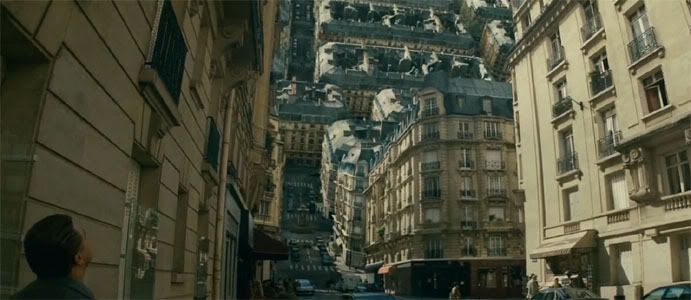
BWOOOOOOOOM!
Okay, that's outta my system.
Inception is indeed my favorite film of the year. When I first saw the trailer, I had no idea what the film was about. I was floored by the spectacular visuals and the trippy scenery. When trying to hype up my sister, I couldn't form words. I just showed her the exact same trailer, and she was hooked.
Inception does what any good Sci-Fi film should; it creates an entire universe that seems grander and more complex than just a single film. Going in, you know nothing about inceptions, extractions, or dream sharing, but coming out, you know everything as if it were common knowledge. On top of that, it's also a psychological thriller, a mystery, and has one of the most debatable ambiguous endings since Blade Runner.
Half of the complaints I heard were viewers didn't understand what was going on; that the science and techniques were under-explained or glossed over. By contrast, the other half of the complainers claimed the movie spent too much time explaining things; that exposition and pandering comprised a majority of the dialogue, and the screenwriter didn't respect the audience's intelligence. Well which is it? Did they explain too much or not enough? Either way, I understood what was going on and never felt confused, bored or insulted, so I must be among the smartest people who saw the film. Go me!
The cast was good despite no outstanding single performance. Marion Cotillard is getting a lot of buzz, but really, I didn't think she was anything special. If anything, I liked her least. It was an ensemble cast, and that's what I remember; the ensemble. The single greatest aspect of the film was the score. I have never seen a score work so well with its accompanying visuals. There is some serious Godel-Escher-Bach science going on here. I've read articles and watched videos detailing the fine details involved, and I'm certain no one without an advanced degree in mathematics could understand everything going on. Hans Zimmer not only deserves the Oscar for best composition, but also a Grammy, an AMA, the Fields Medal and the Stanley Cup.
The special effects were breathtaking. In today's SFX-laden world, I get frequently misanthropic. Everything has to be done with a computer, and everything winds up looking like it was done with a computer. Either no one knows what reality looks like anymore, or we've collectively written a new version of The Emperor's New Clothes. Christopher Nolan is going to save cinema from itself. Greenscreens and Chromakey are the cancer that is killing film. We've become so reliant on computer graphics and animation, nobody knows how to make a film without them anymore (J'accuse, CGI gopher!) Christopher Nolan employs classic analog effects, trick camerawork, clever editing, set design, models, and traditional stuntwork to create the necessary effects, and only uses computers for the truly impossible, IE a city block folding over on itself. And when he does visit the well, he is able to hide the fakiness by not thrusting it into the foreground. It looks *shocker* real!




















